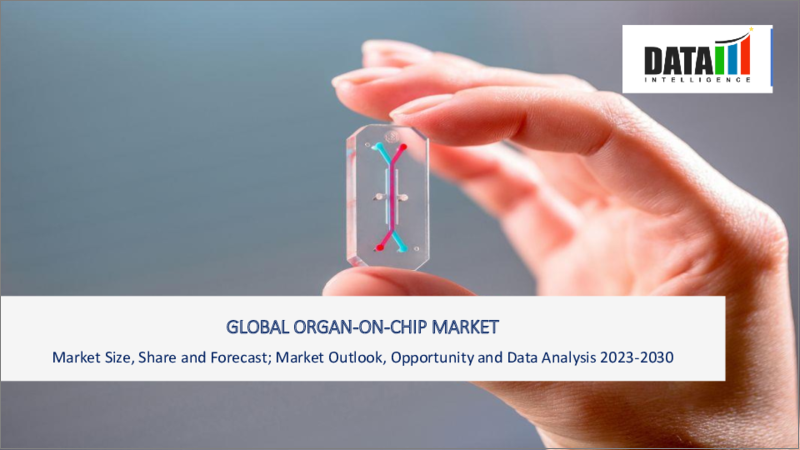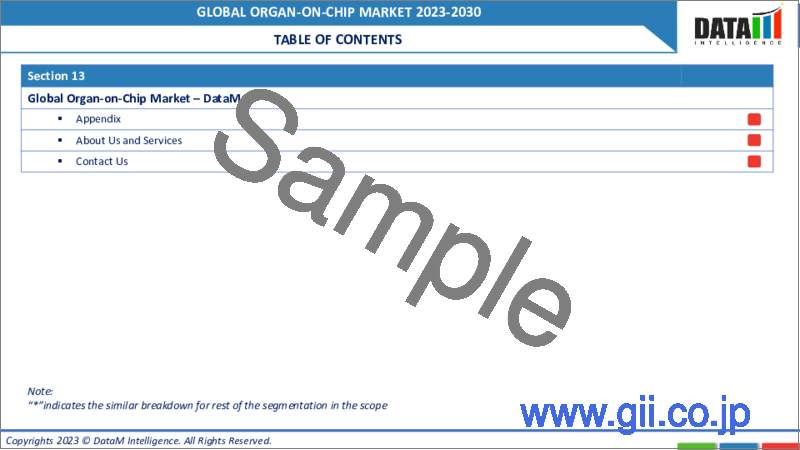|
|
市場調査レポート
商品コード
1285084
臓器オンチップの世界市場- 2023-2030年Global Organ-on-Chip Market - 2023-2030 |
||||||
カスタマイズ可能
適宜更新あり
|
|||||||
| 臓器オンチップの世界市場- 2023-2030年 |
|
出版日: 2023年06月05日
発行: DataM Intelligence
ページ情報: 英文 195 Pages
納期: 即日から翌営業日
|
- 全表示
- 概要
- 目次
市場概要
臓器オンチップの世界市場は、2022年に1億750万米ドルに達し、2030年には7億9,670万米ドルに達すると予測され、予測期間2023年から2030年にかけて29.6%のCAGRで成長すると予測されています。臓器オンチップの市場動向は、疾患の有病率の上昇と研究開発の増加により、創薬に臓器オンチップが大きく採用されていることを示しています。
臓器オンチップ市場の範囲は、肝臓オンチップモデル、肺オンチップモデル、腎臓オンチップモデル、腫瘍モデル、心臓オンチップモデル、カスタム&マルチ臓器オンチップモデル、その他に区分されるモデルで構成され、臓器オンチップ市場のシェアを高めています。臓器オンチップ技術の主な利点は、臓器や組織レベルでの操作反応を持つ詳細なヒトモデルを作成できることで、動物モデルの使用を回避し、パーソナルヘルスケアにおける新薬発見業務を大幅に強化することができることです。
臓器オンチップの世界市場は、市場開拓や医薬品開発における動物実験に代わるニーズが高まっていること、医薬品設計・開発における臓器オンチップを支援するガイドラインや承認が存在することなどの要因により、拡大しつつあります。2023年1月17日、CN Bio Innovations Ltdは、FDAとCN Bio Innovations Ltdが2回目のパートナーシップを拡大すると発表しました。新しい調査では、PhysioMimix Multi-organ Systemを使用して、多臓器MPSとその応用を評価する予定です。
市場力学
動物実験の代替となる臓器オンチップモデルが臓器オンチップ市場の成長を牽引
実験室では、動物にとって現実的で重要なことがすべて否定され、空っぽの細胞に閉じ込められ、社会的に隔離され、心理的なトラウマを負わされます。研究に使われる意識と感情のある存在は、使い捨ての実験器具と同じように扱われるのです。動物研究の大部分は人間の健康を改善するものではなく、動物研究がほとんどの医療開発にどれほどの影響を与えるかは疑問です。
また、厳しい規制政策や法律が存在するため、研究者は動物実験に代わる方法を選択するようになりました。例えば、動物福祉法(AWA)は、調査施設で飼養されている動物の基準を扱う連邦規則です。この規制により、鳥、ラット、魚、爬虫類、マウスなど、約95%の実験動物が禁止され、それ以外の動物については最低限の保護しか受けられません。研究所は、AWAで保護されていない動物を報告する必要はありません。
市場開拓の進展は、メーカーにとって有利な機会を創出します
予想される期間における世界市場の拡大は、オルガンオンチップ産業における製品の発売、パートナーシップ、買収、合併を含む市場の進歩の数の増加によって推進されています。例えば、2022年5月、臓器チップの設計者であるEmulate Inc.は、炎症性腸疾患を研究する研究者向けに、免疫細胞が体内でどのようにトリガーされ分布するかを示すことができる組織モデルで、より高い提供物を導入しました。
さらに、2022年4月、ヴァローヘルスは、3D心臓組織モデリングプラットフォームの設計者であるTARA Biosystemsの買収を完了しました。VALOは、TARAの心臓組織チップを、Opalデータプラットフォームによって、心血管疾患に特化したエンドツーエンドのドラッグデザイン製品に統合することを意図しています。同様に、2022年9月、CiRAの研究チームは、気道組織と血管組織の内皮細胞を用いて呼吸器官を実現するエアウェイ・オンチップを開発しました。
代替品の存在が市場の成長を妨げます
臓器オンチップの代替品が市場に存在することが、予想される期間を通じて世界市場の拡大を阻害しています。組織や臓器の生理をシミュレートするという同様の機能を持つオルガノイドが市場に豊富に存在することが、予測期間中の臓器オンチップ産業の拡大を妨げる大きな障壁となっています。
例えば、2023年2月、高性能ライフサイエンス製品のトッププロバイダーであるMolecular Devices, LLC.と、成人幹細胞由来オルガノイドの領域におけるフロンティアであるHUB Organoids(HUB)は、前臨床から臨床への薬剤消耗の段階的変化を促進する次世代3D生物学の技術の持続的開発を助けることを目的として、共同研究を形成しました。
COVID-19の影響分析
COVID-19パンデミック以前は、臓器オンチップは限られた範囲で医薬品設計・開発に使用されていたが、初期には感染者数が指数関数的に増加し、特定の診断・治療法が利用できないことから研究開発活動が活発化し、臓器オンチップの採用が増加しました。
例えば、感染症の発症メカニズムの解明やCOVID-19の治療法の設計には、動物実験や単層細胞培養が用いられていましたが、バイオエンジニアリングによる臓器オンチップや幹細胞オルガノイドは、生体模倣のインビトロ3次元(3D)組織や臓器の試作に利用される二つの最先端技術として登場したのです。
ロシア・ウクライナ紛争の影響分析
ロシア・ウクライナ紛争は、この地域の主要な市場プレイヤーの数が少ないため、世界のオルガンオンチップ市場に与える影響は少ないと推定されます。しかし、原材料の輸出入の影響は、予測期間中、世界のオルガンオンチップ市場の成長にほとんど影響を与えないと予想されます。
目次
第1章 調査手法と範囲
- 調査手法
- 調査目的および調査範囲
第2章 定義と概要
第3章 エグゼクティブサマリー
- モデル別スニペット
- アプリケーション別スニペット
- スニペット:エンドユーザー別
- 地域別スニペット
第4章 市場力学
- 影響要因
- 促進要因
- 動物実験の代替となる臓器オンチップモデル
- 発展
- 抑制要因
- 置換基の利用可能性
- 機会
- 政府の取り組みと医薬品開発・研究への投資の増加
- 影響分析
- 促進要因
第5章 産業分析
- ポーターの5フォース分析
- サプライチェーン分析
- 価格分析
- 法規制の分析
第6章 COVID-19の分析
- COVID-19の分析
- COVID-19の前のシナリオ
- COVID-19実施中のシナリオ
- COVID-19後のシナリオ
- COVID-19の中での価格・ダイナミクス
- 需給スペクトル
- パンデミック時の市場に関連する政府の取り組み
- メーカーの戦略的な取り組み
- サマリー
第7章 モデル別
- 肝・オンチップモデル
- 肺-オン-チップモデル
- 腎臓オンチップモデル
- 腫瘍モデル
- ハートオンチップモデル
- カスタム・マルチ臓器オンチップモデル
- その他
第8章 アプリケーション別
- 創薬
- 生理モデル開発
- トキシコロジー研究
第9章 エンドユーザー別
- 製薬会社・バイオテクノロジー企業
- 学術・研究機関
- その他
第10章 地域別
- 北米
- 米国
- カナダ
- メキシコ
- 欧州
- ドイツ
- 英国
- フランス
- イタリア
- スペイン
- その他欧州
- 南米
- ブラジル
- アルゼンチン
- その他南米地域
- アジア太平洋地域
- 中国
- インド
- 日本
- その他アジア太平洋地域
- 中東・アフリカ地域
- 地域別の主なダイナミクス
第11章 競合情勢
- 競合シナリオ
- 市況ポジショニング/シェア分析
- M&A(合併・買収)分析
第12章 企業プロファイル
- Emulate Inc.
- 会社概要
- 製品ポートフォリオと説明
- 財務概要
- 主な発展状況
- Mimetas B.V.
- Insphero
- Organovo Holdings
- CN Bio Innovations Ltd
- BiomimX S.r.l.
- AxoSim, Inc.
- Hesperos Inc.
- TissUse GmbH
- Nortis, Inc.
第13章 付録
Market Overview
The Global Organ-On-Chip Market reached US$ 107.5 million in 2022 and is expected to reach US$ 796.7 million by 2030 and is expected to grow with a CAGR of 29.6% during the forecast period 2023-2030. The organ-on-chip market trends show large adoption of organ-on-chip for drug discovery owing to the rising prevalence of disorders and increasing research and development.
The organ-on-chip market scope comprises models segmented as a liver-on-chip model, lung-on-chip model, kidney-on-chip model, tumor models, heart-on-chip model, custom & multi-organ-on-chip models and others, which has increased the organ-on-chip market share. The main advantage of organ-on-a-chip technology is the facility to create a detailed human model that has operational reactions on the level of organs or tissues, thereby bypassing the usage of animal models, as well as immensely enhancing new drug discovery operations for personal healthcare.
The global market for organ-on-chip is expanding as a result of factors including the increasing market developments and the need for an alternative to animal testing in drug development and the presence of supportive guidelines and approvals for organ-on-chip in drug design and development. On January 17, 2023, CN Bio Innovations Ltd announced that the FDA and CN Bio Innovations Ltd are expanding the partnership for the second time. The new research will use the PhysioMimix Multi-organ System to assess multi-organ MPS and their applications.
Market Dynamics
Organ-On-Chip Model an Alternative to Animal Testing Drives The Growth Of The Organ-on-Chip Market.
Further to the suffering of the true investigations, animals in laboratories are denied everything realistic and crucial to them, they are restricted to empty cells, socially secluded, and psychologically traumatized. The conscious and emotional beings used in research are treated in the same manner as disposable lab equipment. The bulk of animal research does not improve human health, and it is questionable how much of an impact animal research has on most medical developments.
Also, the presence of stringent regulatory policies and laws is pushing researchers to opt for alternatives to animal testing. For instance, the Animal Welfare Act, or AWA, is a federal regulation that handles the criterion of maintenance animals acquire at investigation establishments. This regulation bans approximately 95% of the animals tested like birds, rats, fish, reptiles, and mice, and delivers only minimal protection for the rest. Labs are not needed to report non-AWA-protected animals.
Increasing Market Development Creates Lucrative Opportunities For Manufacturers.
The global market expansion in the anticipated term is being driven by the rising number of market advancements, including product launches, partnerships, acquisitions and mergers in the organ-on-chip industry. For instance, in May 2022, organ-on-a-chip designer Emulate Inc. introduced an elevated offering for investigators researching inflammatory bowel disorder with its tissue model that permits the demonstration of how immune cells are triggered and distributed in the body.
Additionally, in April 2022, Valo Health completed the acquisition of TARA Biosystems, designers of a 3D cardiac tissue modeling platform. Valo intended to integrate TARA's cardiac tissue chips into an end-to-end drug design offering strived at cardiovascular disorder, pushed by its Opal data platform. Similarly, in September 2022, the CiRA research team developed an airway-on-a-chip that enacts respiratory organs employing endothelial cells from airway tissue and vascular tissue.
Availability of Substituents Will Hamper The Growth Of The Market.
The existence of an alternative to organs-on-chips on the market is impeding the expansion of the global market throughout the anticipated time. The market's abundance of organoids, which have the similar function of simulating tissue and organ physiology, is a significant barrier to the expansion of the organ-on-chip industry over the forecast period.
For instance, in February 2023, Molecular Devices, LLC., a top provider of high-performance life science products, and HUB Organoids (HUB), the frontiers in the domain of adult stem cell-derived organoids, formed a collaboration aimed at aiding the persistent development of next-generation 3D biology technologies that facilitates a step-change deduction in pre-clinical to clinical drug attrition.
COVID-19 Impact Analysis
Before the COVID-19 pandemic, organ-on-chip was employed in drug design and development to a limited extent but during the initial period, the number of infected individuals was increasing exponentially, and the unavailability of particular diagnostic and treatments called for increased research and development activities which led to growth in the adoption of organ-on-chip devices.
For instance, although animal prototypes and monolayer cell cultures were employed for pathogenesis investigations and the design of COVID-19 treatment, bioengineered organs-on-chips, and stem cell organoids have appeared as two cutting-edge technologies utilized to create biomimetic in vitro three-dimensional (3D) tissue or organ prototypes.
Russia-Ukraine War Impact Analysis
The Russia-Ukraine conflict is estimated to have a low impact on the global organ-on-chip market, owing to the low number of key market players in this region. However, the impact of the import and export of raw materials is expected to have little influence over the global organ-on-chip market growth over the forecast period.
Segment Analysis
The global organ-on-chip market is segmented based on model, application, end user and region.
Drug Discovery From the Application Segment Accounts For 49.4% Of Market Share Owing To Rising Research And Development.
Compared to conventional 2D cell cultures, organ-on-chip platforms can be employed for high-throughput screening of drug candidates in an environment that is more physiologically realistic. Organ-on-chip platforms enable researchers to test and assess the safety and efficacy of drug candidates in a more realistic environment by simulating the microenvironment and functional characteristics of certain organs or tissues. Earlier in the drug discovery process, this can assist uncover possible lead compounds or eliminate hazardous or ineffective candidates, saving time and resources.
The pharmacokinetics (PK) of drug candidates, including their absorption, distribution, metabolism, and excretion (ADME) characteristics, can be studied using organ-on-chip platforms in a more physiologically comparable setting. In addition, almost 44,000 Americans have drug-induced liver infections (DILI). Therefore, creating a liver-on-a-chip technology would be crucial for several diagnostic and therapeutic fields, especially for creating novel treatments for long-term illnesses like hepatitis B, liver cirrhosis, and hepatocellular cancer.
Geographical Analysis
North America Accounted For Approximately 44.8% Of The Market Share Owing To The Strong Presence Of Major Players And Increasing Technological Advancements.
Manufacturers have chances to expand their operations in this region because of the rising demand for organ-on-chip for advancements in North America. The area has many producers and its rapid economic development has raised industrial production of organ-on-chips models. Using cutting-edge technologies, such as 3D bioprinting, Organovo Holdings, Inc., a company that specializes in three-dimensional (3D) biology, successfully took its first inflammatory bowel disease model toward the next stage of target discovery and validation for Crohn's disease.
Furthermore, the growing partnership, adoption and awareness initiatives for organ-on-chip are also contributing to the growth of the regional market in the forecast period. For instance, on May 19, 2021, the collaboration between InSphero AG, a leader in 3D cell-based assay technology, and Hamilton, a leading provider of automated liquid handling equipment, aims to enhance the creation and management of 3D microtissues (spheroids). These factors show the dominance of North America.
Competitive Landscape
The major global players in the organ-on-chip market include: Emulate Inc., Organovo Holdings, Mimetas B.V., AxoSim, Inc., Insphero, CN Bio Innovations Ltd, TissUse GmbH, Hesperos Inc., and Nortis, Inc. among others.
Why Purchase the Report?
- To visualize the global organ-on-chip market segmentation based on model, application, end user and region, as well as understand key commercial assets and players.
- Identify commercial opportunities by analyzing trends and co-development.
- Excel data sheet with numerous data points of organ-on-chip market-level with all segments.
- PDF report consists of a comprehensive analysis after exhaustive qualitative interviews and an in-depth study.
- Product mapping available as Excel consisting of key products of all the major players.
The global organ-on-chip market report would provide approximately 53 tables, 54 figures and 195 Pages.
Target Audience 2023
- Manufacturers/ Buyers
- Industry Investors/Investment Bankers
- Research Professionals
- Emerging Companies
Table of Contents
1. Methodology and Scope
- 1.1. Research Methodology
- 1.2. Research Objective and Scope of the Report
2. Definition and Overview
3. Executive Summary
- 3.1. Snippet by Model
- 3.2. Snippet by Application
- 3.3. Snippet by End User
- 3.4. Snippet by Region
4. Dynamics
- 4.1. Impacting Factors
- 4.1.1. Drivers
- 4.1.1.1. Organ-On-Chip Model an Alternative for Animal Testing
- 4.1.1.2. Increasing Market Developments
- 4.1.2. Restraints
- 4.1.2.1. Availability of Substituents
- 4.1.3. Opportunity
- 4.1.3.1. Increasing Government Initiatives and Investment in Drug Development and Research
- 4.1.4. Impact Analysis
- 4.1.1. Drivers
5. Industry Analysis
- 5.1. Porter's 5 Force Analysis
- 5.2. Supply Chain Analysis
- 5.3. Pricing Analysis
- 5.4. Regulatory Analysis
6. COVID-19 Analysis
- 6.1. Analysis of COVID-19
- 6.1.1. Scenario Before COVID-19
- 6.1.2. Scenario During COVID-19
- 6.1.3. Scenario Post COVID-19
- 6.2. Pricing Dynamics Amid COVID-19
- 6.3. Demand-Supply Spectrum
- 6.4. Government Initiatives Related to the Market During Pandemic
- 6.5. Manufacturers Strategic Initiatives
- 6.6. Conclusion
7. By Model
- 7.1. Introduction
- 7.1.1. Market Size Analysis and Y-o-Y Growth Analysis (%), By Model
- 7.1.2. Market Attractiveness Index, By Model
- 7.2. Liver-On-Chip Model *
- 7.2.1. Introduction
- 7.2.2. Market Size Analysis and Y-o-Y Growth Analysis (%)
- 7.3. Lung-On-Chip Model
- 7.4. Kidney-On-Chip Model
- 7.5. Tumor Models
- 7.6. Heart-On-Chip Model
- 7.7. Custom & Multi-Organ-On-Chip Models
- 7.8. Others
8. By Application
- 8.1. Introduction
- 8.1.1. Market Size Analysis and Y-o-Y Growth Analysis (%), By Application
- 8.1.2. Market Attractiveness Index, By Application
- 8.2. Drug Discovery *
- 8.2.1. Introduction
- 8.2.2. Market Size Analysis and Y-o-Y Growth Analysis (%)
- 8.3. Physiological Model Development
- 8.4. Toxicology Research
9. By End User
- 9.1. Introduction
- 9.1.1. Market Size Analysis and Y-o-Y Growth Analysis (%), By End User
- 9.1.2. Market Attractiveness Index, By End User
- 9.2. Pharmaceutical & Biotechnology Companies *
- 9.2.1. Introduction
- 9.2.2. Market Size Analysis and Y-o-Y Growth Analysis (%)
- 9.3. Academic & Research Institutes
- 9.4. Others
10. By Region
- 10.1. Introduction
- 10.1.1. Market Size Analysis and Y-o-Y Growth Analysis (%), By Region
- 10.1.2. Market Attractiveness Index, By Region
- 10.2. North America
- 10.2.1. Introduction
- 10.2.2. Key Region-Specific Dynamics
- 10.2.3. Market Size Analysis and Y-o-Y Growth Analysis (%), By Model
- 10.2.4. Market Size Analysis and Y-o-Y Growth Analysis (%), By Application
- 10.2.5. Market Size Analysis and Y-o-Y Growth Analysis (%), By End User
- 10.2.6. Market Size Analysis and Y-o-Y Growth Analysis (%), By Country
- 10.2.6.1. The U.S.
- 10.2.6.2. Canada
- 10.2.6.3. Mexico
- 10.3. Europe
- 10.3.1. Introduction
- 10.3.2. Key Region-Specific Dynamics
- 10.3.3. Market Size Analysis and Y-o-Y Growth Analysis (%), By Model
- 10.3.4. Market Size Analysis and Y-o-Y Growth Analysis (%), By Application
- 10.3.5. Market Size Analysis and Y-o-Y Growth Analysis (%), By End User
- 10.3.6. Market Size Analysis and Y-o-Y Growth Analysis (%), By Country
- 10.3.6.1. Germany
- 10.3.6.2. The U.K.
- 10.3.6.3. France
- 10.3.6.4. Italy
- 10.3.6.5. Spain
- 10.3.6.6. Rest of Europe
- 10.4. South America
- 10.4.1. Introduction
- 10.4.2. Key Region-Specific Dynamics
- 10.4.3. Market Size Analysis and Y-o-Y Growth Analysis (%), By Model
- 10.4.4. Market Size Analysis and Y-o-Y Growth Analysis (%), By Application
- 10.4.5. Market Size Analysis and Y-o-Y Growth Analysis (%), By End User
- 10.4.6. Market Size Analysis and Y-o-Y Growth Analysis (%), By Country
- 10.4.6.1. Brazil
- 10.4.6.2. Argentina
- 10.4.6.3. Rest of South America
- 10.5. Asia-Pacific
- 10.5.1. Introduction
- 10.5.2. Key Region-Specific Dynamics
- 10.5.3. Market Size Analysis and Y-o-Y Growth Analysis (%), By Model
- 10.5.4. Market Size Analysis and Y-o-Y Growth Analysis (%), By Application
- 10.5.5. Market Size Analysis and Y-o-Y Growth Analysis (%), By End User
- 10.5.6. Market Size Analysis and Y-o-Y Growth Analysis (%), By Country
- 10.5.6.1. China
- 10.5.6.2. India
- 10.5.6.3. Japan
Australia
- 10.5.6.4. Rest of Asia-Pacific
- 10.6. Middle East and Africa
- 10.6.1. Introduction
- 10.6.2. Key Region-Specific Dynamics
- 10.6.3. Market Size Analysis and Y-o-Y Growth Analysis (%), By Model
- 10.6.4. Market Size Analysis and Y-o-Y Growth Analysis (%), By Application
- 10.6.5. Market Size Analysis and Y-o-Y Growth Analysis (%), By End User
11. Competitive Landscape
- 11.1. Competitive Scenario
- 11.2. Market Positioning/Share Analysis
- 11.3. Mergers and Acquisitions Analysis
12. Company Profiles
- 12.1. Emulate Inc. *
- 12.1.1. Company Overview
- 12.1.2. Product Portfolio and Description
- 12.1.3. Financial Overview
- 12.1.4. Key Developments
- 12.2. Mimetas B.V.
- 12.3. Insphero
- 12.4. Organovo Holdings
- 12.5. CN Bio Innovations Ltd
- 12.6. BiomimX S.r.l.
- 12.7. AxoSim, Inc.
- 12.8. Hesperos Inc.
- 12.9. TissUse GmbH
- 12.10. Nortis, Inc.
LIST NOT EXHAUSTIVE
13. Appendix
- 13.1. About Us and Services
- 13.2. Contact Us





